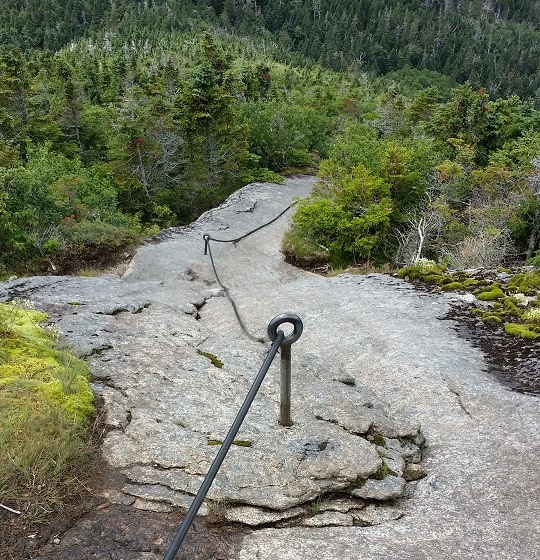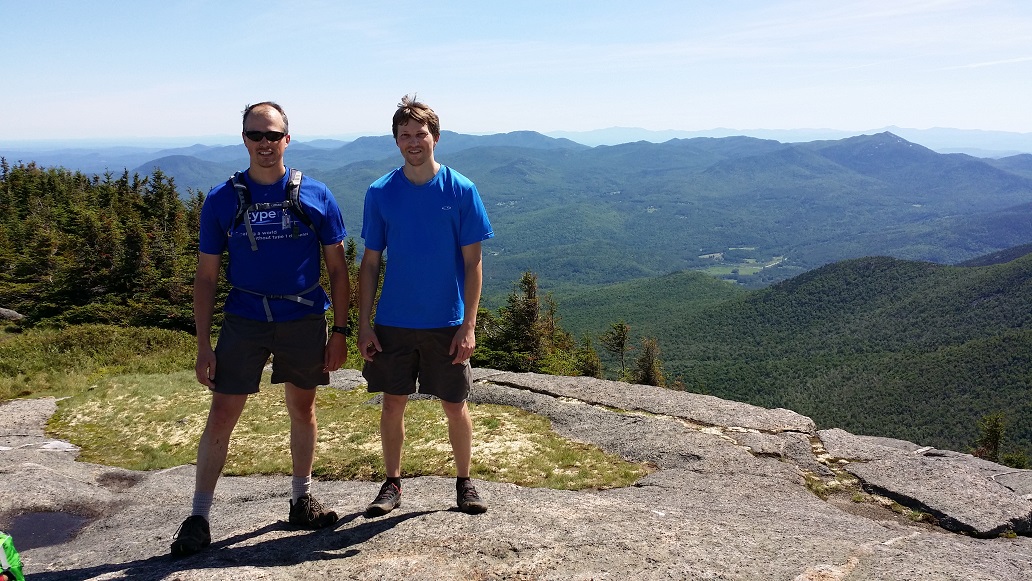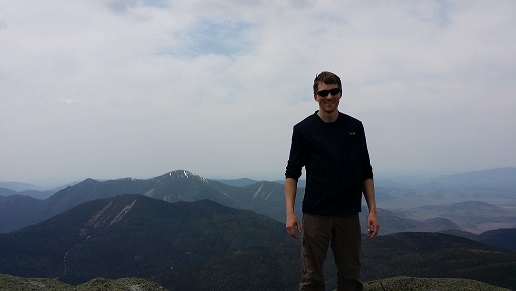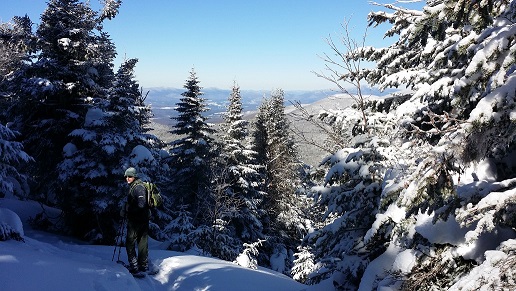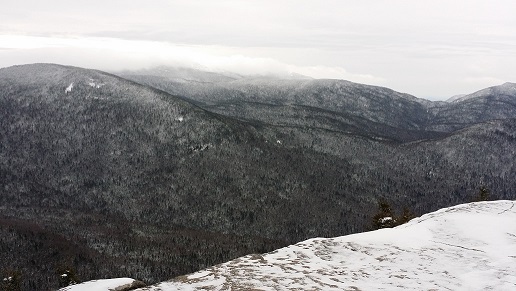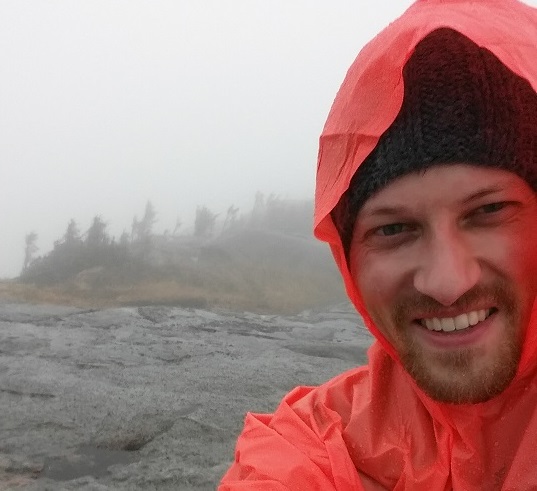I suspect most hikers have one pivotal hike that changed everything, that opened their eyes to what is possible, to a deeper sense of what the mountains have to offer, to what the human body is truly designed for and capable of. This is the story of mine, when I learned to flow with the current of the mountains, and the struggle of the hike turned to weightless joy.
Hike: Lower Great Range
Distance: 17 miles
Total Ascent: ~5000 ft
Date: July 26, 2015
Electronic dance music blasted from Zebra Supervan’s sound system, the bone shaking beat keeping me awake and drowning out my nerves. “You’re fine. Everything’s fine,” I told myself again. Perhaps once more and I’d believe it. I get nervous entering into new situations, especially alone. Night was settling in and I was heading north on I-87, to a place I’d never been, to do something I’d never done, to push my body farther than it had ever been pushed before.
A few hours earlier my ex-wife had sent me off with a hug when she picked up the kids. I asked her if I smelled like a hamburger. I had just grilled them for dinner, and didn’t want a bear mistaking me for one. She was the only person I had confessed my plans to, not wanting to worry my family. At least someone would know to sound the alarm if I failed to return.
This was to be my first solo hike, and not a small endeavor. For months I had been wanting to push the limits of my body and see what I was really capable of, as well as try out a solo experience. My chosen target was the Great Range, a 12 mile 7 peak range in the heart of the High Peaks, containing some of the most challenging trails in the Adirondacks. I had no illusions of doing the entire range in a day, as some ultra-hikers do. I just figured I’d get up there and see how far I got. If things went well, I might even double the four High Peaks currently under my belt. I felt I had the stamina for it, but lack of experience and my struggle with arthritis left a lot to chance. I could only trust in myself to handle the former, and hoped ibuprofen could successfully suppress the latter, as it had helped on Marcy two months prior.
My destination this night was the trailhead parking lot known as The Garden. I had not been there before, and had no idea what to expect. Would it be full already? Would I be the only one sleeping there? Was sleeping there even allowed? Would it be deserted and a target for the Boogeyman to harass idiot hikers in the middle of the night?
I found the turn off Route 73 at the Ausable Inn in Keene Valley, and slowly crept up the narrow winding road out of town, into the black wilderness. A giant boulder right up against the road, a one lane bridge, small cabins with a single light on, all engraved themselves into my memory. A few hikers were walking down the road with headlamps, finishing their long day, apparently unable to park in the lot that morning. This did not bode well. But onward I crept into the forest, until the road became a narrow single dirt lane, and finally, around 10:30, I came to a STOP sign.
Spread before me, illuminated by my headlights, surrounded by giant trees, was a large dirt parking lot scattered with cars. A few hikers milled about with headlamps, packing up, their adventures complete. I felt like an interloper, shining my artificial light and disturbing the night creatures. There was no turning back now, no pretending I was never there.
A few spaces were open. I pulled into one, killed my engine, and cut my lights. All went black and quiet, save for a few muffled voices drifting in. I allowed the stillness to settle over me for a few minutes to give my eyes and mind time to adjust. Then I donned my own headlamp and stepped out into the cool mountain air. Using the red beam to save my night vision, I made my way back to the parking attendant’s shed, long since deserted, to slip my fee into the slot and get my ticket.
Back in my car, I settled in for the night by popping open the hard cider and book I had brought. Planning ahead paid off. After reading by headlamp for a bit, cider drained, I scurried down into my sleeping bag and quickly overheated, my body turning the unventilated car into a humid sauna. Cracking the windows an inch made all the difference, and I drifted in and out of sleep listening to gentle rain.
Around 5am I figured I had pieced together at least a few hours of sleep, and, wanting to make the most of the day, decided to get moving. I nibbled on hard boiled eggs and washed them down with cold coffee I had brewed at home. Attempting to exit Zebra, my heart instantly shot into hyper-speed as my car alarm blared into the silent morning. Apparently one must unlock the car door with the key fob if that’s the way it was locked.
Just after 6 I hit the trail, only the 3rd to sign in at the register that morning. The air was cool, but thick and heavy with humidity from the night’s rain. It gave the forest a mystical surreal quality. My excitement was quickly growing and I ran the easier sections of trail to get my furnace fired up.

According to my map, the trail split after a short bit, leading to trails on both sides of Johns Brook. I planned to take a left, crossing to the east side of the river earlier to avoid having to backtrack to hit the start of the climb up into the Wolfjaws. However, when I arrived at the junction I was faced with my first dilemma. There was a large Trail Abandoned sign, stating that a bridge was out and the trail no longer maintained following the hurricane years earlier. I wasn’t excited to diverge from the itinerary I had left behind in case something went wrong, but I wasn’t excited about difficulties I might find with an abandoned trail, either. I decided the former was the lesser of two evils, being a far more trafficked and well-maintained trail, and forged ahead on the west side of the river.
Being tall has great advantages in hiking. Longer strides cover ground quickly and efficiently. The frequent small cliffs and rocks found in the Adirondacks are easily scaled. Spiderwebs are easily caught with one’s face first thing in the morning. Actually, nix that last one. I was driven close to the brink of insanity by web after web after web. Finally wising up, every time I came near a crop of bushes, I’d wave my poles in front of me. Sorry, spiders. I hope you found a safer spot to rebuild.

About 3 miles in, I finally encountered fellow human life forms. They had just packed up camp and were heading out. Right after that camping area, the trail heads a bit downhill to a junction and interior registry. Bearing right would take me to Johns Brook Lodge (JBL), which provides rustic but comfortable accommodations (and food!) on the interior for those not looking to camp. However, I was going left, as it was time to do what I had come here for, climb.
Passing the quiet DEC interior outpost log cabin in a stunning grassy field overlooking Johns Brook at the foot of the Great Range, I came to a suspension bridge. Bouncing across it, it was time to head left and backtrack a little down the abandoned trail in order to find the junction to the trail that heads up into the notch between the Wolfjaws. The trail really did have an abandoned feel to it, which I found disconcerting, and worried that I might have difficulty finding the junction. I thought I had it once, but decided it didn’t look quite right and continued on. I’m glad I did, because a short while later I found the actual junction to be obvious and well-marked.



Up, up, up I climbed. It seemed to go on forever. I started wondering what the hell I was doing here and if it would ever end as my legs burned and I started to sweat profusely. Eventually I came to a lean-to, and crossed out into a small stream from which a few guys were filling water bottles, having just awoken. I should say, the stream itself was small. The path of the stream was utter destruction, a barren wasteland from another planet, perhaps 50 feet wide in places. The power of water in these mountains is intense. This is not a place to find yourself standing during a storm, when a trickling stream can turn into a raging river in moments, taking everything down with it. And I mean everything. It got me thinking about the concept of “conquering the mountains” and how misguided that is. There is no conquering the mountains. I began conversing in my head with Mother Earth and the mountains, asking permission to join and enjoy them for the day.

After taking a short breather, I moved beyond the destruction and found my stride at a pace I could live with, and trekked on. I finally reached the junction with the Great Range Trail right at the top of the notch between Lower and Upper Wolfjaws. I took a left, planning a quick up and back to get Lower Wolfjaw. The trail immediately doubled in intensity, becoming far more rugged and steep. Thankfully it is a pretty short climb, and I reached the top without incident.

My 5th high peak occurred at 9:15am on that July morning, 5.5 miles from my car, all alone and quiet, with no views to speak of due to trees and clouds. I was amazed to discover that, despite having just climbed nearly 3,000 feet and covering nearly 6 miles, I felt fresh, and the struggle and fatigue I had felt earlier in the climb had not grown, but actually faded. I felt energized and ready to tackle the next one.


Back down I bounded, reaching the bottom of the notch in short order. The climb out of the other side of the notch to Upper Wolfjaw is a bit longer, and even more rugged. I laughed at the playground of obstacle after obstacle, my pace becoming a crawl. This was definitely a step up from anything I had encountered before. Reaching the false summit, a short reprieve was enjoyed, but then it was back down and another steep climb up to the actual summit. A small side trail lead to a giant rock, which I could only assume was the high point. It was 11am and already I had two more high peaks under my belt. I was dancing with the mountains, and I wanted more.



Reaching the col between Upper Wolfjaw and Armstrong, my concept of “rugged” was challenged yet again. This was getting serious. I walked 20 feet, climbed straight up for 20 feet, walked 20 feet, climbed straight up for 20 feet, over and over again. I was really glad I had worked so hard to get my upper body in shape, as I was using it more than my legs at this point. I was also quite cognizant of how much my height was helping me scale these short cliffs. I have no idea how shorter people manage this section, but kudos to them.



An hour later I stumbled out onto the cliffs of the summit of Armstrong, thankful that section was behind me, and hopeful I wouldn’t have to return that way. To avoid a return trip, I would at least have to summit one more, Gothics, and descend via its cable route. But for now, the clouds were swirling their way over and out of the peaks, leaving behind absolutely breathtaking views of the rest of the Great Range, and I took in my 7th high peak summit experience.


A Canadian man was finishing up his lunch on the summit. He was the first person I had encountered since the pair halfway up Wolfjaws Notch several hours earlier, and it was good to have some company for a bit. He had just climbed the same section with a full overnight pack. I was astounded that was even possible. He was a very experienced backpacker, out for several days mountain hopping, finding places between them to bed down at night. I found him inspiring, and he strongly encouraged me to make it all the way to Haystack, the last mountain in the range, that day. I scoffed, quite certain that was beyond what I had in me, especially since I planned to drive the 4 hours home afterward. But it certainly was intriguing.
After having a bit of food myself and chatting for a while, I decided to head off in the direction of Gothics. He was about to depart the same way, so I waved and said, “See you on the next one!” and took off. The descent down Armstrong was far easier than the ascent up the other side, and shortly I came to a trail junction at the base of the col. A young man was there taking a break, drinking from a water bottle with a Sawyer filter attached, having just climbed up from the east side. Gothics is a destination mountain many people do by itself, and the trail that comes up to this junction from the Adirondack Mountain Reserve (AMR) land is reputedly the easiest route. As such it is more heavily traveled, and even while chatting there for a few minutes, more people came up, huffing and puffing, having just completed the majority of the climb. Not wanting to mill about in a crowd after having been alone all morning, I moved on.


The climb up Gothics out of the col was quite easy. In no time at all, somewhat in disbelief after the struggles earlier on Upper Wolfjaw and Armstrong, I found myself on the summit. It was 1pm, and I had just completed my 4th high peak of the day, doubling my total. And Gothics is an impressive one. Ranked 10th in the state at 4,736 feet, it has sheer drops on both sides and 360 degree views from right in the heart of the High Peaks region. I sat down to breathe it in and have a snack.


There was only one other person on the summit when I arrived. Within a few minutes more arrived, and then more, and more. My Canadian friend also came along as I was getting ready to head out. I smiled and greeted him. We studied the map together, and he asked, “So, how far are you going to go?” I responded, “I’m still not sure. I guess I’ll just play it by ear.” I was still feeling pretty good. Astoundingly so, really. I had been popping a few ibuprofen throughout the day, and my energy levels still felt high, and aches and pains low. But I was also weary of the time. It was now after 1pm, and Zebra Supervan, ever patiently awaiting my return, was a very long way away. I figured I would descend down off Gothics to the next trail junction in the col, and then decide whether it was time to head out, or if I wanted to make a run at the next mountain, Saddleback.
Gothics has a false summit to the south, the direction I was heading. The trek between them is easy and quick. I passed a man heading in the opposite direction toward the actual summit. He asked, “Is this the way to the summit?” “Yup, you’re almost there,” I replied. He said, “OK, I thought so. There are two women back there who I could not convince they weren’t on the real summit.” I laughed and went on to see what I could do. A few minutes later, rounding a bend, the trail came to the cliffs on the false summit. On the cliffs were two of the most beautiful women I had ever seen, lying on the rocks, sunning themselves. Immediately they asked if this was the real summit. I said, no, I had just come from the real one. They were so exhausted from having just climbed up the cable route that they weren’t convinced it was worth the effort. I reassured them it was an easy 10 minute walk, and they had already come all this way with the hard part behind them. I never did find out if they did it in the end. At least meeting them gave my mind something to do during the rest of my hike.


Off I went to discover what the cable route was all about and get myself down off this mammoth mountain. I wasn’t particularly concerned about it. I have always enjoyed a bit of technical climbing, and figured as long as I had a cable to hold onto, I’d be fine. But at the top, there is no cable. I found myself on the precipice of a thousand foot sheer drop. I gently lowered myself down section by section, exposed to an extent where a slip would mean certain disaster and death. One slip and there would be no stopping the fall. Gingerly I descended, my heart racing faster than it had during any of the ascents. Mercifully, I came upon the start of the cable, a thick black piece of rubber running down the side of the mountain through giant metal eye hooks drilled into the rock face. Quickly I lowered myself down, grateful for the extra support, always having one hand on the cable.


When the cable ended, the path was still steep, but marginally less so, and the scrub brush lining the trail was getting taller and thicker. I started walking down, upright, feeling more confident now. Pride goeth before a fall. I should have thought of that before my foot slipped. My hand reflexively shot out to the side and grabbed some scrub brush, stabilizing myself and staving off a worse fate. My shoes had nubs on the soles made for traction in mud. It turns out they are not so good for smooth bare rock. As I stood still and waited for my heart to return to its normal position and tempo in my chest, I decided it would be best to crab walk the remainder of the descent.
And so on I went, down on all fours, belly up and feet first, for the remainder of the notorious Gothics cable route. Finally hitting the base of the col at the next trail junction, it was decision time. The trail sign said Saddleback was only a half mile away. But the drain from the day was beginning to bare its teeth. But what’s another half mile after all I’d done? And it would mean 5 peaks in one day. I decided to go for it, and then I could decide whether to backtrack down to this junction and head out, or maybe even be crazy enough to go after number 6.

The half mile up Saddleback was pretty rugged, but nothing as bad as what I had already done, and went uneventfully. It’s a steep climb for the first half, and then the second half goes over and across the saddle to the other side where the Saddleback cliffs are, and the actual summit. My 9th high peak occurred at 2:45 that afternoon, the 5th of the day. I could not have been happier. But it was getting late, and I had 7.5 miles to return. I sat down on the cliff’s edge to take in the views of Basin and Haystack before me, and had a bite to eat. It was so quiet and still that I could hear the chatter of a group several hundred feet below me and a half mile away crossing the col.



It became clear to me that I was done. This was my turn-around point. Time and energy reserves made it obvious that continuing farther out away from my car would not be a wise choice. So after resting for 10 minutes, I got up to leave. Pain instantly shot down the back of my right knee, stiffening the joint. It didn’t feel like the normal arthritic pain I was used to, but I popped a few more ibuprofen anyway and limbered about trying to loosen it up. My mind raced, wondering how I was going to do the descent like this, and cursing myself. What kind of moron goes searching for his body’s limit and trips flat-faced over it? Oh, there it is! Now what? Now you get yourself down the mountain, dumbass.
Hobbling back across the saddle, I dreaded the descent to come. Thankfully the flat section seemed to help loosen the knee up some, and I picked my way back down, crab walking again at times, all the way to the junction. From the junction, it heads steeply down the Orebed Brook Trail. More crab walking. Crab walking forever. I’d estimate I crab walked close to a mile in total. Or at least so my hands claim.
Still more than 6 miles from the parking lot, the trail, an eroded combination of fallen branches, mud, and bare rock, broke out from the trees onto a different planet altogether. The Orebed Brook slide is a vast swath of bare bright white rock, in the middle of nowhere. It stopped me in my tracks. I had never experienced anything quite like it. And this wasn’t a scar from the hand of man, but another example of the power of water in these mountains. I worked my way down the slide, looking for cairns and the yellow painted blaze markers. And then I came to something even more unexpected. Stairs. Stairs that went on and on and on, beyond what I could even see. Quickly I descended, down, down, down, noting by the spike marks in the wood how these stairs probably come in quite handy in the winter. Also, I thought of the builders of these stairs, carving out the braces, cutting the steps, drilling them into the rock, countless flights, miles from anywhere.


Finally reaching the last of the steps, I paused and looked up. Immediately before me, at the bottom of the slide, was an unfathomable pile of trees, washed down like a jumble of matchsticks. Towering above was another high peak, Big Slide. I felt both lost and found in the wilderness all at once, alone on the planet, yet at home. The trail made a sharp right, and I dove back into the woods.

A new dilemma was becoming increasingly urgent. It had been a long, hot summer day, and I had been working hard and sweating profusely for most of it. The 3 bottles of water I brought had been emptied, and I was getting thirsty. Once up on the Great Range Trail, being at the high point of the ridge all day, I hadn’t encountered a single spot to fill up. I knew I should be hitting the brook soon and this far down it should be enough to filter from. The problem was that my knee felt a bit better as long as I kept moving, and I feared a stop to refill would cause another lock-up. Of course, becoming severely dehydrated was a worse fate, so as soon as I encountered a good spot in the stream I made a pit stop to get out my filter.

The water was rust colored, but I figured the filter would remove anything dangerous, and if I got a little extra iron in my diet, all the better. Not wanting to stop for too long, I only filled up 2 of the 3 bottles, and then got moving again. I was happy to discover that my knee stayed relatively loose, and I quickly hobbled on.
All day I had been hopping from peak to peak, obstacle to obstacle, junction to junction. It was great fun, and kept the journey lively and interesting. Now in this section of trail, it became a gradual and easy descent, and I was able to find my rhythm. My mind quieted and it became meditative. My hiking poles became another set of legs, my eyes automatically scoped the rocks, trees, and mud before me, and my body mindlessly navigated them with an ease I had never known before. The miles ticked by, and I was able to just breathe it all in, the ground effortlessly rolling under me. This was what my body was designed for, an off-road vehicle of incredible efficiency capable of covering any terrain for any distance. This was pure joy. This was hiking.
Occasionally my mind would drift to finding the two women cooling off in one of the many streams I crossed, but alas, such situations are better left to fantasy anyway. I did pass a lean-to with a gaggle of hikers settling in for the evening and enjoying joyful conversations. It momentarily brought me back to reality and I thought, this would be a great spot to spend a night some time. Not on a weekend. Too people-y.
I came upon the junction to cross Johns Brook over to the lodge, and slowly began to awaken from my dream. Signs marked the start of the ADK property, which owns and operates JBL. A couple chatted and laughed, cuddling inside the cocoon of a hammock hung over the bubbling brook. Shortly I broke out from the bushes and saw the lodge for the first time up close, entertained by the thought that I had seen the green roof as a tiny dot from thousands of feet above and miles away many hours earlier.

People. So many people. There were probably only 10 or 20, but their voices drifted into my ears from every angle. It felt so strange after having been alone for most of the day. Becoming a tad overwhelmed, I only paused to grab a picture before moving on, ready to tackle the final 3.5 miles.
My knee continued to twinge on the way out, but as long as I kept moving it was pretty minor, and I was largely able to meditate my way through it once again. I did have one brief but memorable chat with an older couple on their way in to camp for the night. He had recently undergone knee surgery, and his joy and gratitude to be out there hiking again, enjoying this incredible wilderness, was bubbling over. I could relate.
Four years prior to this hike I could barely walk due to severe arthritis, and I had just completed a hike I never would have thought possible, before or after my episode, and it had permitted me to see and experience things beyond my imagination. I had left my house only 24 hours earlier, and felt like I had journeyed all the way around the world and back. I was a different man. My self-imposed limitations had been shoved way the hell out. I would never look at myself or hiking the same way again.
Arriving back to my car just before 6pm, I removed my shoes, socks, and shirt. I didn’t know bodies could smell like that. I didn’t know feet could look like that. I was not thrilled by the prospect of spending the next four hours locked up in a car with myself, but had little choice. The bright side of sitting down was I discovered the knee pain disappeared.
It was around Albany that what I had done really hit me. The endorphins and blasting music inflated my chest to the bursting point, and I screamed, “Fuck yeah! Fuuuuuucccccckkkkkk yeeeeeeeaaaaaahhhhhhh!!!!” With that out of the way, all I could do was grin from ear to ear. I had done it. I had not only overcome my fears, but had even surpassed what I thought possible. 17 miles and 5,000 feet vertical on some of the most notoriously rugged trails in the Northeast. 5 peaks, bringing my total from 4 all the way to 9 on my journey to the 46. It wasn’t without its difficulties, but it had gone shockingly well, and I had learned and experienced so much.
And then there was hunger. So much hunger. As the endorphins faded and the fatigue began to settle over me, all I could think of was food. I decided I’d pick up some take-out on my way into town, not having anything substantial and quick to eat at home (another lesson learned – plan ahead!). So I asked Google what time various places around my house closed. But it was Sunday night, and everything closed at 10. I wouldn’t be arriving until well after that.
It was 10:30pm when I hobbled and creaked my way into Wegmans, covered in mud within a cloud of my own stink. I felt like the bog monster creeping out of the woods to frighten civilized damsels. Thankfully it was largely empty, and I quickly grabbed a steak and a bag of frozen french fries. I paid, averting my eyes from the cashier to avoid my own embarrassment, and finally went home.
A shower never felt so cleansing. Food never tasted so replenishing and delicious. And my bed never felt so warm and welcoming. It was 1am as I drifted off to sleep, a changed man after 31 of the most epic hours of my life.

